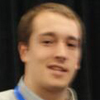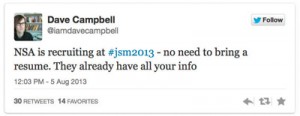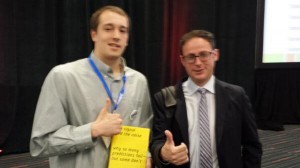 Lee Richardson graduated from the University of Washington with a double major in mathematics and statistics. He works as a data analyst for the Institute of Health Metrics and Evaluation in Seattle and plans to earn a PhD in statistics.
Lee Richardson graduated from the University of Washington with a double major in mathematics and statistics. He works as a data analyst for the Institute of Health Metrics and Evaluation in Seattle and plans to earn a PhD in statistics.
I took extremely diligent notes throughout my first JSM so I could write a thorough report for anyone in a similar position next year. Just kidding, I actually only started writing things down after Nate Silver encouraged everyone to start blogging.
Nate Silver’s address was definitely the most anticipated part of the week for me. My primary goal for the conference was to get him to sign my copy of The Signal and the Noise and get a picture with him. Mission accomplished! I showed up to Silver’s address 45 minutes prior, hoping to get this picture/signature combination, and luckily (or sadly) I was the first one there. Silver showed up with ASA President Marie Davidian (another person on my “must meet” list) about five minutes after me and I was easily able to approach him, get the book signed, and get the picture taken. I actually was able to talk to him for 2–3 minutes about the new Five Thirty Eight, how he plans to cover statistics in education, and whether he was going to try to poach Kevin Pelton from ESPN Insider (he isn’t). In hindsight, I was actually smart to have showed up early, because he was absolutely swarmed after his address.
Primary Advice for First-Timers
1. When in doubt, choose the introductory lectures.
2. Try to get as much cool stuff from the expo as possible. Hint: For many publishers, it costs more to ship the textbooks back than to give them away. Hence, if you’re persistent, you can get lots of free things. Also, enter all the drawings you can.
3. Don’t feel bad if you get lost watching a lecture. Everyone I spoke to acknowledged that it’s hard to comprehend presentations unless they’re in your specific field.
4. If you’re not locked into a specific research field, explore other fields of statistical research.
5. Take at least one day to explore the city.
I was very curious to see the reaction Silver got from the largest gathering of statisticians in the world. I received mixed opinions of Silver from most of the people I talked to at the conference. Some thought he was monumental for increasing the visibility of statistics as a discipline, some were unimpressed with his methods, and some didn’t know much about him. Personally, I love Silver. I thought his book was extremely well written, entertaining, and had a lot of great thoughts on statistical thinking, as well as an interesting introduction to lots of applications.
Because of the mixed perspectives I got prior to the address, I was bracing for a tense and awkward Q&A discussion. I thought people who were not particularly impressed with his work were going to really try to put him on the spot. That didn’t occur, and the Q&A went smoothly (maybe because the question platform was via Twitter). My favorite part came when he was asked about communicating statistics with politicians, a point of emphasis that has been discussed recently. Silver responded, “Oh, I don’t know. I try to go around politicians.” Haha!!
Aside from the Silver speech, there was a lot going on at #JSM2013. I was astonished at how large the statistical community is and how many niches and subfields there are within the field. That’s one of the coolest things about being a statistician, you can “play in everyone’s backyard” (a famous quote from John Tukey). Whether your interests are in public health, environment, finance, or technology, you could find someone who shares your interests at JSM.
Due to the sheer size of the field, arriving at JSM was somewhat overwhelming. The night before, I was going over the program for about an hour and went to sleep without a clue as to what events I was going to attend. The best advice I received for this was on Monday, when a Stanford graduate student told me my best bet was to just attend introductory lectures. This makes a lot of sense on a couple levels. For starters, I got funding for JSM through STATMOS (Statistical Methods for Atmospheric and Oceanic Sciences), and the meeting for them was all day Sunday. When people were presenting their research, the complexity of their presentations shot over my head within the first five minutes. More demoralizing was that, after these presentations, the three directors of STAMOS’s (Peter Guttorp, Montse Fuentes, and Michael Stein, the latter two on my “must meet” list. Guttorp got me funding to go; he’s from UW) comments on these presentations eclipsed my brain even further. While at first this was intimidating, I exhaled after talking to one of Michael Stein’s students, who described Stein as “an oracle.” He said many of Stein’s comments on his research went over his head, and it was months later when he finally understood what he was saying.
This complexity turned out to be a common theme for most presentations I went to the first day. As it turns out, unless it’s your specific field of research, most presentations will be tough to follow (unless maybe you’re an oracle). That’s the beauty of the introductory lectures; they are just giving you an introduction to whatever field they are covering, and it’s meant to be easy to understand. After being in over my head the first day, I converged to only attending introductory lectures. This is my best advice for people attending JSM for the first time in Boston next year. When in doubt, choose the introductory lectures!!
This also touches on something my professor June Morita told me during the year. Especially if you’re an undergraduate like me, it’s a good idea to become exposed to all sorts of statistical applications, and then you will be more likely to find something you are really passionate about. Who knows what you’ll be interested in a couple years from now? It’s better to have a broader knowledge of multiple disciplines than to be locked into one and realize you’re not as into it as you expected you would be.
Another suggestion for JSM first-timers would be to spend a good portion of time in the expo hall. This is where all of the booths are set up and the easiest place for overwhelmed newbies to have conversations. It was here where I signed up for about 20,000 raffles and came away with many free, useful things. For starters, I now have enough pens, sunglasses, and lanyards to last a lifetime. I talked my way into two free textbooks, retweeted Springer Statistics (#TweetForATee!) for a tee shirt, bought another, and generally talked to a ton of interesting people.
The funniest part of the expo hall was definitely the cluster in the corner consisting of the NSA, Facebook, and Monsanto. I couldn’t have done a better job clustering three companies from different sectors and evil reputations if I had tried. All we needed was Goldman Sachs or Chase and I would have lost my mind. The Facebook booth was especially funny, as a Tom from MySpace lookalike challenged people to an IQ test of sorts to see if they had what it took to be a Data Scientist, a job title that has been a cause of serious debate in the science community. (Clearly, I’m a Facebook hater, constantly between deactivation and debating deactivation. Ironically, I actually re-activated my Facebook after the conference because I thought the picture of me and Nate Silver was so epic.)
I actually talked to people at the NSA booth for a while and came away feeling pretty good about their mission. The rep explained to me how they have been unfairly characterized by the media and urged me to read their press release. Having been a government employee for the past couple years, I have a soft spot for fellow public servants. The “government is evil” narrative is extremely digestible, and it’s easier to label them as evil spies than figure out what they’re actually doing.
Additional Post-Musing Blogs About JSM2013
Statsbylopez — Michael Lopez
Citizen-Statistician — Rob Gould, Mine Çetinkaya-Rundel, and Andy Zieffler
Perhaps the most stunning part of the expo was the sheer size of the statistical software market. There were tons of companies looking to gain a share of the market, and it must be for good reason, evidenced by the recent riches Seattle-based Tableau just acquired. The most riveting battle of the week was certainly between Minitab and SAS over lanyard dominance. Minitab cleverly placed their lanyards in the bags we received upon checking into the conference, and this became the obvious place to display your nametag. Not to be outdone, SAS responded by really pushing their lanyards on those who entered their booth at the expo. Minitab’s initial brilliance definitely won out over the course of the week, but it really sets the stage for an epic battle next year in Boston. Will SAS respond with a second lanyard in the check-in bag? Will Minitab have something else up their sleeve? The statistical world will be watching.
Editor’s Note: Reprinted from Lee Richardson’s Blog with permission.
To read Lee Richardson’s blog and see more photos from JSM, visit his page. To view many of the tweets during JSM and Nate Silver’s talk, visit Ramnath Vaidyanathan’s storify page.






Leave a Reply